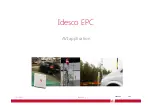...the world's most energy friendly microcontrollers
2014-07-02 - Tiny Gecko Family - d0034_Rev1.20
421
www.silabs.com
25 DAC - Digital to Analog Converter
0 1 2 3
4
DAC
...0100010...
...0101110...
Quick Facts
What?
The DAC is designed for low energy
consumption, but can also provide very good
performance. It can convert digital values
to analog signals at up to 500 kilo samples/
second and with 12-bit accuracy.
Why?
The DAC is able to generate accurate analog
signals using only a limited amount of energy.
How?
The DAC can generate high-resolution
analog signals while the MCU is operating
at low frequencies and with low total power
consumption. Using DMA and a timer, the
DAC can be used to generate waveforms
without any CPU intervention.
25.1 Introduction
The Digital to Analog Converter (DAC) can convert a digital value to an analog output voltage. The DAC
is fully differential rail-to-rail, with 12-bit resolution. It has two single ended output buffers which can be
combined into one differential output. The DAC may be used for a number of different applications such
as sensor interfaces or sound output.
25.2 Features
• 500 ksamples/s operation
• Two single ended output channels
• Can be combined into one differential output
• Integrated prescaler with division factor selectable between 1-128
• Selectable voltage reference
• Internal 2.5V
• Internal 1.25V
• V
DD
• Conversion triggers
• Data write
• PRS input
• Automatic refresh timer
• Selection from 16-64 prescaled HFPERCLK cycles
• Individual refresh enable for each channel
• Interrupt generation on finished conversion
• Separate interrupt flag for each channel
• PRS output pulse on finished conversion
• Separate line for each channel
• DMA request on finished conversion
• Separate request for each channel
• Support for offset and gain calibration
Summary of Contents for EFM32TG
Page 543: ......

















